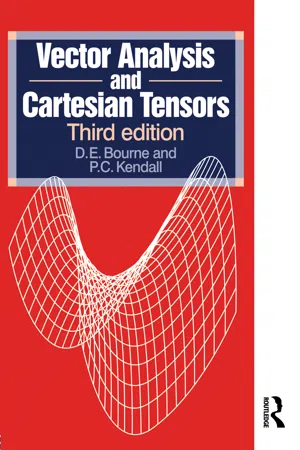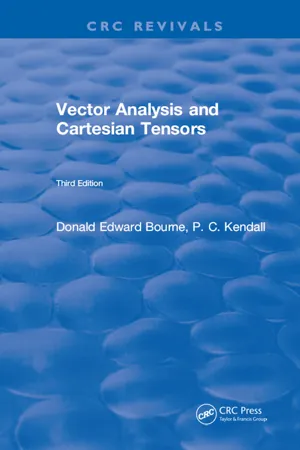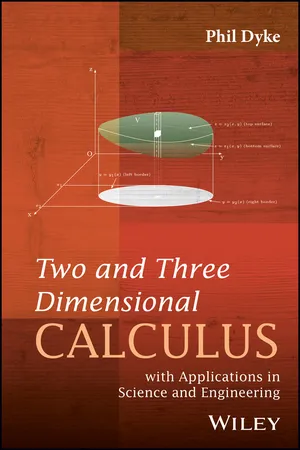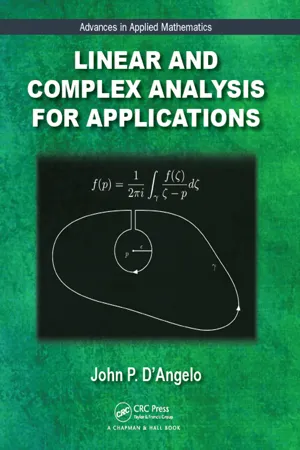Technology & Engineering
Divergence Theorem
The Divergence Theorem, also known as Gauss's Theorem, is a fundamental theorem in vector calculus. It relates a surface integral over a closed surface to a volume integral over the region enclosed by the surface. In engineering and physics, it is used to relate the flow of a vector field through a closed surface to the divergence of the field within the enclosed volume.
Written by Perlego with AI-assistance
Related key terms
5 Key excerpts on "Divergence Theorem"
- P C Kendall(Author)
- 2017(Publication Date)
- Routledge(Publisher)
6 Integral theorems6.1 INTRODUCTION
In Chapter 4 , scalar and vector fields were defined and the properties of gradient, divergence, and curl were discussed; and in Chapter 5 we were concerned with various integrals of scalar and vector fields, and the techniques whereby such integrals are evaluated. The ground has thus been prepared for the two central theorems in vector analysis: (i) the Divergence Theorem (also called Gauss’s theorem ), which relates the integral of a vector field F over a closed surface S to the volume integral of div F over the region bounded by S ; and (ii) Stokes’s theorem which relates the integral of a vector field F around a closed curve to the integral of curl F over any open surface S bounded by . In this chapter we shall prove these theorems and some related results.6.2 The Divergence Theorem (Gauss’s Theorem)
Definitions
1. A simple closed surface S is said to be convex if any straight line meeting it does so in at most two points.2. A simple closed surface S will be called a semi-convex surface if axes Oxyz can be so chosen that any line drawn parallel to one of the axes and meeting S either (i) does so in just one or just two points, or (ii) has a portion of finite length in common with S .The Divergence TheoremA closed region V is bounded by a simple closed surface S . If the vector field F is defined and continuously differentiable throughout V , thenProof∬ sF.dS =∭ vdiv F d V . ( 6.1 )The result will first be proved, in part (a), for a region V bounded by a convex surface S . The theorem will then be extended to more general regions in parts (b), (c) and (d).(a) Take rectangular axes Oxyz and denote by ℜ the projection of S on to the xy -plane. Divide S into upper and lower parts,SUandSL, as viewed from ℜ (Fig. 6.1 ). Let a line drawn parallel to Oz from a point in ℜ cutSLat P andSUat Q , and denote the z -coordinates of P, Q byZp , ZQ (zP <zQ ). All points (x, y, z ) in V are covered if x and y range over all values in ℜ and the corresponding values of z range fromzPtozQ- eBook - ePub
Vector Analysis and Cartesian Tensors
Third Edition
- Donald Edward Bourne(Author)
- 2018(Publication Date)
- Chapman and Hall/CRC(Publisher)
Integral theorems 6 6.1 INTRODUCTIONIn Chapter 4 , scalar and vector fields were defined and the properties of gradient, divergence, and curl were discussed; and in Chapter 5 we were concerned with various integrals of scalar and vector fields, and the techniques whereby such integrals are evaluated. The ground has thus been prepared for the two central theorems in vector analysis: (i) the Divergence Theorem (also called Gauss’s theorem), which relates the integral of a vector field F over a closed surface S to the volume integral of div F over the region bounded by S; and (ii) Stokes’s theorem which relates the integral of a vector field F around a closed curve C to the integral of curl F over any open surface S bounded by C . In this chapter we shall prove these theorems and some related results.6.2 THE Divergence Theorem (GAUSS’S THEOREM) Definitions1. A simple closed surface S is said to be convex if any straight line meeting it does so in at most two points.2. A simple closed surface S will be called a semi-convex surface if axes Oxyz can be so chosen that any line drawn parallel to one of the axes and meeting S either (i) does so in just one or just two points, or (ii) has a portion of finite length in common with S.The Divergence TheoremA closed region V is bounded by a simple closed surface S. If the vector field F is defined and continuously differentiable throughout V, then
Proof=∬ SF. d S∭ Vdiv F d V .(6.1) The result will first be proved, in part (a), for a region V bounded by a convex surface S. The theorem will then be extended to more general regions in parts (b), (c) and (d).(a) Take rectangular axes Oxyz and denote by R the projection of S on to the xy-plane. Divide S into upper and lower parts, SU and SL , as viewed from R (Fig. 6.1 ). Let a line drawn parallel to Oz from a point in R cut SL at P and SU at Q, and denote the z-coordinates of P, Q by zP , zQ (zP < zQ ). All points (x, y, z) in V are covered if x and y range over all values in R and the corresponding values of z range from zP to zQ - eBook - ePub
Mathematical Physics
An Introduction
- Derek Raine(Author)
- 2018(Publication Date)
- Mercury Learning and Information(Publisher)
Gauss’s theorem . The aim of this section is to derive this theorem for some special cases.We start by considering a vector field B and a closed surface S enclosing a volume V . The Divergence Theorem says the flux of B (outwards) through the closed surface is equal to the integral of the net divergence inside the volumeExample 13.13 Verify the Divergence Theorem for a simplified case in which B = (b (x ), 0, 0) is a vector field in the x -direction, with b (x ) depending only on x , and V is a cuboid with faces X 1 and X 2 of areas A perpendicular to B .The normal component of B on X 2 isBx= b (x 2 ). The flux of B through X 2 issinceBxis constant on X 2 . Similarly the flux of B through X 1 into V is (area)×(normal component) since the normal component B x is constant onX1, thusThe net flux out of the volume is the sum of the net flux out of each face. As the vector field is along the x -direction, crossing only the surfaces X 1 and X 2 , these are the only faces with non-zero flux. Therefore the net flux is the difference of the flux out of X 2 and the flux into X 1 , i.e.We want to relate the expression for Δflux to ∇∙ B , so we bring in derivatives of b (x ):However, sincewhereWe can write Then orBx= b (x ),By= 0 andBz= 0, soThis example shows us the physical meaning of the divergence of a vector field. The divergence of a field gives the rate per unit volume at which flux is being gained or lost from a point. If we think of a vector field as a fluid flowing through space (the arrows representing the velocity at each point) then we gain or lose flux where there are sources or sinks of the fluid. At a point where ∇ ∙ B = 0 there are no sources or sinks. And if there are no sources or sinks inside a volume, then ∇ ∙ B - eBook - ePub
Two and Three Dimensional Calculus
with Applications in Science and Engineering
- Phil Dyke(Author)
- 2018(Publication Date)
- Wiley(Publisher)
Secondly, note that on the curve has zero component, so even if did have a non-zero component, it would play no part in the calculation of the path integral. Using the derived expressions we have, on, and the right-hand side is integrated between the limits 0 and to traverse the circle. The only non-zero contribution comes from the term, and the integration is straightforward (use) giving the answer. Any piecewise smooth surface having the border will have the same surface integral as a consequence of Stokes' theorem. Those who know about electric charge might find this less surprising, but it shows the power of Stokes' theorem. Figure 11.2 The paraboloid and its bounding curve on the plane. There are more applications of Stokes' theorem to come, but first there is another theorem to introduce, this time connecting surface and volume integrals. 11.3 Gauss' Divergence Theorem In the introduction to Chapter 10, there was a section explaining how surface integrals occur naturally when calculating the flux of a quantity through a surface. If that surface is closed, then it is tempting to think that this flux must be zero, but that discounts the possibility that material is either being created or lost from inside this closed surface. Such a surface does not have contain something exotic like a black hole, it could be a two-dimensional fluid problem that contains a drain or a tap. Therefore, although the flux through a closed surface may not be zero, there must be a relationship between the amount of a material either being lost or being created inside the closed surface and the flux of the same material through the surface. This relationship is encapsulated in the following theorem that connects surface and volume integrals. Theorem 11.3 If, a simple solid region with bounding surface and is a vector field differentiable inside and on, then Proof First this will be proved for the case where is a cuboid. The cuboid is shown in Figure 11.5 - eBook - ePub
- John P. D'Angelo(Author)
- 2017(Publication Date)
- CRC Press(Publisher)
It arises in Maxwell’s equations and it tells us how to perform integration by parts in higher dimensions. We state it only in three dimensions, but the analogue of formula (12) holds in all dimensions. Theorem 5.2. Let S be a positively oriented piecewise-smooth surface in ℝ 3 bounding a region Ω. Suppose E = (P, Q, R) is continuously differentiable on and inside S. Then ∬ S E ⋅ d S = ∭ Ω div (E) d V. (12) P ROOF. We merely sketch one possible proof. First one proves the result for a rectangular box. See Figure 8 below. As in the proof of Green’s theorem, the result follows for objects built from such rectangular boxes. Then one approximates a nice surface by such objects. □ The left-hand side of (12) measures the flux of E across S. Since it equals the right-hand side, the divergence measures flux per volume. E XAMPLE 5.1. We compute Example 4.2 using the Divergence Theorem. The surface S is defined by z = R 2 − r 2 on the top, and z = 0 on the bottom. Since E = (x, y, z), we get div(E)= 3. Hence ∬ S E ⋅ d S = ∭ Ω 3 d V = 3 ∫ 0 R ∫ 0 R 2 − r 2 ∫ 0 2 π r d θ d z d r = 3 2 π R 4 One of the most important and illuminating examples concerns the electric field due to a point charge, which we place at the origin. For an appropriate constant a, depending on the units used, we have F IGURE 8. Orientation of a rectangular box E = a (x, y, z) (x 2 + y 2 + z 2) 3 2. (13) To better understand this field, put r (x, y, z) = x 2 + y 2 + z 2, the distance to (0, 0, 0). The function 1 r gives the electric potential away from the origin. Then ∇ (− 1 r) = 1 2 (x 2 + y 2 + z 2) 3 2 (2 x,2 y,2 z) = (x, y, z) (x 2 + y 2 + z 2) 3 2 Then the flux across a sphere of radius R about the origin. is ∬ S R E ⋅ n d S = a ∬ S R (x, y, z) (x 2 + y 2 + z 2) 3 2 ⋅ (x, y, z) (x 2 + y 2 + z 2) 1 2 d S = a ∫ ∫ S R 1 R 2 d S = a R 2 4 π R 2 = 4 π a = q[--=PLGO-SEP. ARATOR=--]ϵ 0. (14) In (14) we have introduced the charge q and the permittivity constant ϵ 0
Learn about this page
Index pages curate the most relevant extracts from our library of academic textbooks. They’ve been created using an in-house natural language model (NLM), each adding context and meaning to key research topics.




